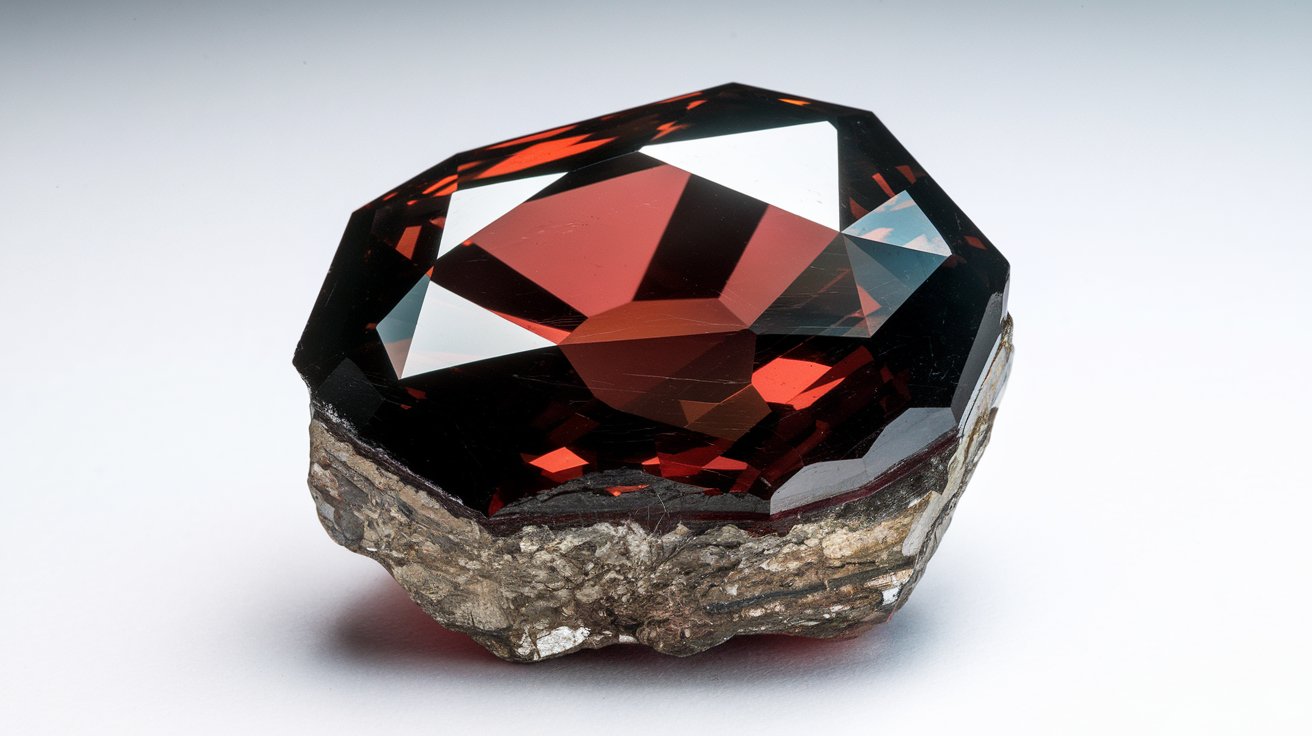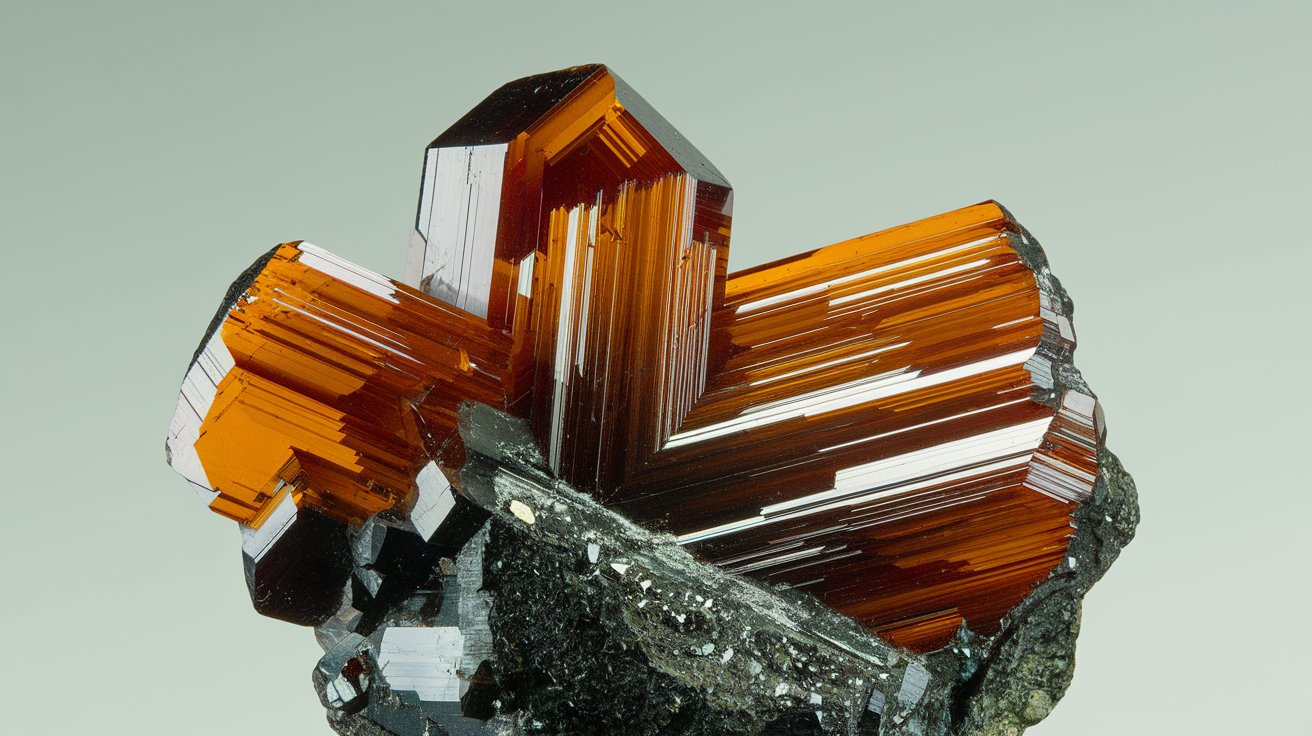
What makes almandine so special? Almandine, also known as almandite, is a gem that has fascinated people for thousands of years. This deep red garnet, named after the ancient city of Alabanda, boasts a rich history and remarkable properties. Its chemical formula, Fe3Al2Si3O12, reveals its iron and aluminum composition. Almandine's durability, with a Mohs hardness of 7.0–7.5, makes it perfect for jewelry. Found in metamorphic rocks and gem gravels worldwide, it has been treasured by ancient Egyptians and Romans. Connecticut even named it their state gemstone. Whether you're a gem enthusiast or a geology student, almandine's allure is undeniable.
Key Takeaways:
- Almandine, a captivating gemstone, has a rich history and unique properties. Its deep red color, durability, and cultural significance make it a favorite among gem enthusiasts and geologists alike.
- Almandine, also known as almandite, is a fascinating mineral belonging to the garnet group. Its physical, optical, and magnetic properties contribute to its popularity in jewelry and industrial applications.
What is Almandine?
Almandine, also known as almandite, is a fascinating mineral belonging to the garnet group. Its rich history and unique properties make it a favorite among gem enthusiasts and geologists alike. Let's dive into some intriguing facts about this captivating gemstone.
-
Origin of the Name
The name "almandine" comes from the city of Alabanda in Asia Minor, a significant center for garnet cutting and trade in ancient times. -
Chemical Composition
Almandine is an iron alumina garnet with the chemical formula Fe3Al2Si3O12. This composition places it in the ferrous iron end member of the garnet group. -
Crystal System
It crystallizes in the cubic space group Ia3d, with a unit-cell parameter a ≈ 11.512 Å at 100 K. This structure is typical of garnet group minerals. -
Color
Known for its deep red hue, almandine's color can range from reddish-orange to purplish-red, influenced by elements like magnesium or manganese. -
Cleavage
Unlike many minerals, almandine does not exhibit cleavage, making it more durable and resistant to cracking.
Physical Properties of Almandine
Almandine's physical properties contribute to its popularity in jewelry and industrial applications. Here are some key characteristics.
-
Fracture
Almandine has a conchoidal fracture, breaking with a smooth, curved surface, ideal for cutting and polishing into gemstones. -
Hardness
With a Mohs hardness of 7.0–7.5, almandine is relatively hard and resistant to scratching, perfect for jewelry. -
Luster
Its luster ranges from greasy to vitreous, depending on the crystal quality. Polished almandine often exhibits a vitreous to subadamantine luster. -
Streak
The streak of almandine is white, a useful characteristic for mineral identification. -
Specific Gravity
Almandine's specific gravity is 4.05 ± 0.25 − 0.12, indicating its density is slightly higher than water.
Optical and Magnetic Properties
Almandine's optical and magnetic properties are equally fascinating, contributing to its unique appearance and behavior.
-
Optical Properties
Almandine is single refractive and often shows anomalous double refractive properties. Its refractive index is approximately 1.790 ± 0.030. -
Birefringence
Unlike many minerals, almandine does not exhibit birefringence, meaning it doesn't split light into different colors under a polarizing microscope. -
Pleochroism
Almandine does not show pleochroism, the property of changing color when viewed from different angles. -
Dispersion
With a dispersion of 0.024, almandine's ability to split light into its component colors is relatively low compared to other minerals like diamonds. -
Ultraviolet Fluorescence
Almandine is inert under ultraviolet light, meaning it doesn't fluoresce or emit light when exposed to UV radiation. -
Absorption Spectra
It typically shows absorption bands at 504, 520, and 573 nm, with faint lines at 423, 460, 610, and 680–690 nm.
Occurrence and Localities
Almandine is widely distributed across the globe, found in various rock types and regions.
-
Occurrence
Almandine occurs in metamorphic and pegmatitic rocks and is often found in gem gravels, particularly in Sri Lanka, where it's called "Ceylon ruby." -
Localities
Significant deposits are found in India, Pakistan's Swat Valley, Sri Lanka, Thailand, Zambia, Tanzania, southern Kenya, Idaho, and Alaska.
Cultural and Historical Significance
Almandine has been cherished for thousands of years, playing a significant role in various cultures and historical periods.
-
Cultural Significance
Used in jewelry for millennia, the Ancient Egyptians utilized almandines as early as 3,500 BCE. Pliny the Elder referred to the finest red gemstones, including almandines, as "carbunculus." -
State Gemstone
Connecticut has designated almandine as its state gemstone, recognizing its historical and cultural importance. -
Gemstone Classification
Classified as a gemstone due to its durability and attractive color, almandine is often cut into cabochons to enhance its brilliance, known as a carbuncle.
Scientific Studies and Industrial Uses
Almandine's unique properties make it a subject of scientific research and industrial applications.
-
Solid Solution Series
Almandine forms a solid solution series with pyrope, another garnet species, involving the substitution of magnesium for iron, resulting in different colors and compositions. -
Magnetic Properties
Almandine is antiferromagnetic with a Néel temperature of 7.5 K, containing two equivalent magnetic sublattices contributing to its magnetic properties. -
Inclusions
It often contains inclusions like apatite, zircon, spinel, and rutile, forming diagnostic patterns like asterisms visible under specific lighting conditions. -
Asterism
Asterism occurs when incoming light reflects off inclusions like rutile needles, forming a star pattern on the stone's surface, more common in cabochon-cut almandines. -
Rarity of Asterism
Asteriated garnets are rare and not commonly used in jewelry due to their unique inclusions. Some rare examples exhibit six-rayed stars. -
Cleaning and Care
Almandines are durable but require careful cleaning. Avoid extreme heat or ultrasound, as these can cause microscopic inclusions to burst and fracture the gem. Use a soft brush, mild detergent, and warm water instead. -
Historical Names
Almandine was sometimes called "Syrian" garnet due to its purplish-red color, highly sought after in ancient times. This name persisted until the end of the 19th century. -
Gem Quality
Gem-quality almandine is relatively rare and sought after by collectors. The best specimens have minimal inclusions and optimal color. -
Trade Names
In the past, almandines were sometimes mistaken for rubies and sold as "Australian rubies" due to their similar appearance, leading to the term "Australian ruby" in trade. -
Industrial Use
Coarse varieties of almandine are often crushed and used as an abrasive agent, useful in various industrial applications. -
Scientific Studies
Almandine has been studied using X-ray diffraction and Mossbauer spectroscopy, providing insights into its crystal structure and magnetic properties. -
Crystallography
Crystallographic studies reveal its cubic structure and unit-cell parameters, crucial for understanding its physical and chemical properties. -
Mossbauer Spectroscopy
Mossbauer spectroscopy studies the iron content in almandine, providing detailed information about the iron's oxidation state and its role in the mineral's magnetic behavior.
Garnet Group and Gemological Classifications
Almandine's place within the garnet group and its gemological classifications highlight its significance in mineralogy and gemology.
-
Garnet Group
Almandine belongs to the garnet group, which includes other species like pyrope and spessartine, forming a series with varying compositions and colors. -
Gemological Classifications
Gemological classifications by E. Ya. Kievlenko (1980) include almandine as a significant member of the garnet group, helping identify and evaluate gemstones based on their composition and properties.
Jewelry and Educational Value
Almandine's use in jewelry and its educational value make it a versatile and valuable mineral.
-
Jewelry Applications
Used in jewelry due to its attractive color and durability, almandine is often cut into cabochons to enhance its brilliance, known as a carbuncle. -
Antique Jewelry
Almandine has been used in antique jewelry, particularly in the Classical Roman period. The term "carbuncle" persisted into the 19th century, referring to cabochon-cut red gems, most commonly almandine garnets. -
Educational Value
Almandine serves as an educational tool for geology and mineralogy students. Its widespread occurrence and diverse properties make it an excellent subject for studying mineralogy and gemology. -
Historical Significance
Almandine's historical significance extends beyond its use in jewelry. It has symbolized wealth and power throughout history, reflecting the cultural and economic importance of gemstones in ancient civilizations.
Almandine's Timeless Appeal
Almandine, with its rich history and striking properties, stands out as a gem of great significance. From its deep red hues to its durable nature, this garnet has captivated people for millennia. Its presence in ancient jewelry, its role as Connecticut's state gemstone, and its use in modern gemology highlight its enduring allure. Whether found in metamorphic rocks or gem gravels, almandine's unique characteristics, like conchoidal fracture and lack of cleavage, make it a favorite among jewelers and collectors. Its magnetic properties, inclusions, and occasional asterism add to its scientific intrigue. Almandine's journey from ancient trade centers to contemporary studies showcases its timeless appeal. This gem, celebrated for its beauty and resilience, continues to be a symbol of wealth and power, reflecting its cultural and historical importance. Almandine remains a fascinating subject for both gem enthusiasts and scientists alike.
Frequently Asked Questions
Was this page helpful?
Our commitment to delivering trustworthy and engaging content is at the heart of what we do. Each fact on our site is contributed by real users like you, bringing a wealth of diverse insights and information. To ensure the highest standards of accuracy and reliability, our dedicated editors meticulously review each submission. This process guarantees that the facts we share are not only fascinating but also credible. Trust in our commitment to quality and authenticity as you explore and learn with us.


